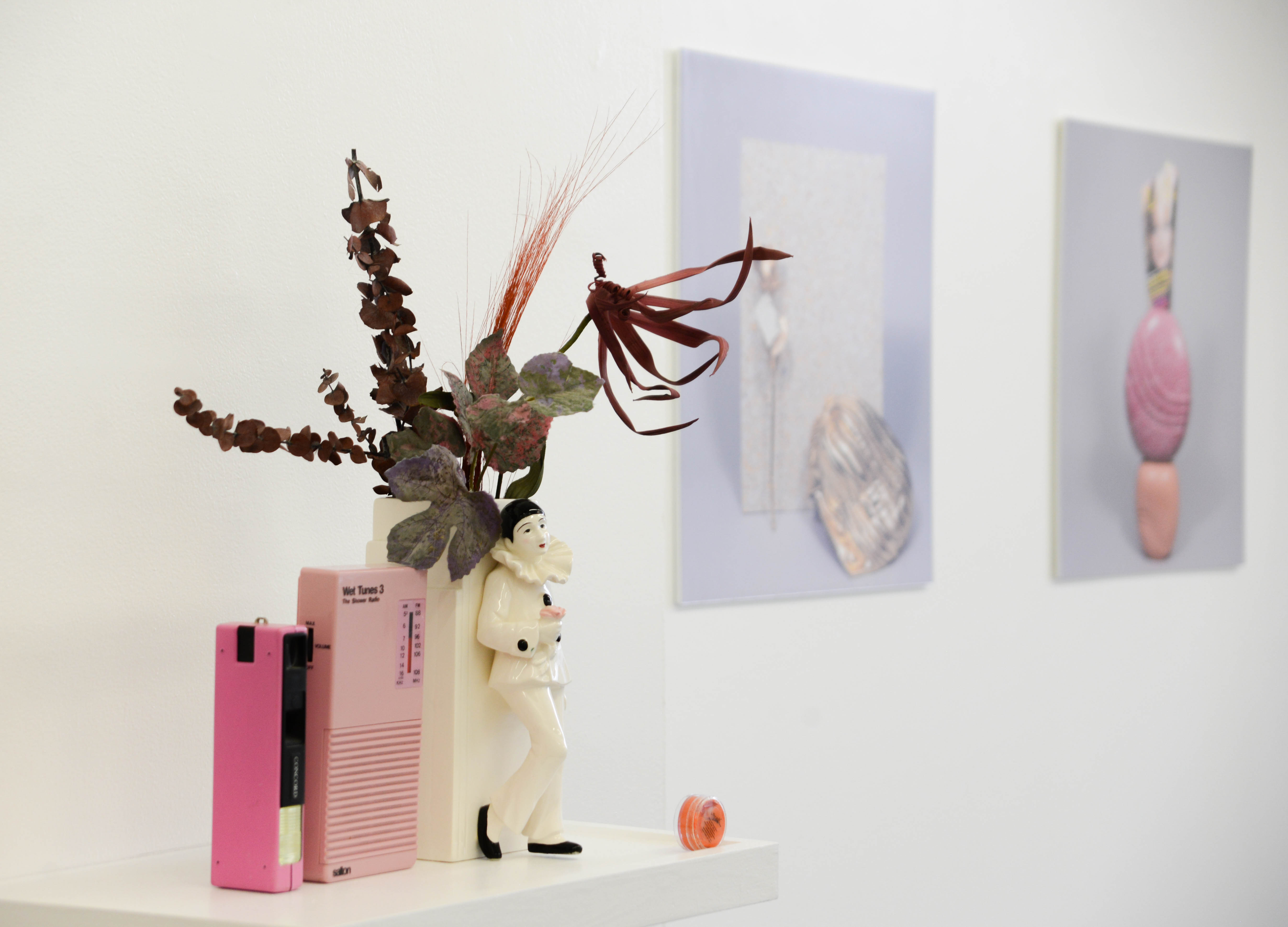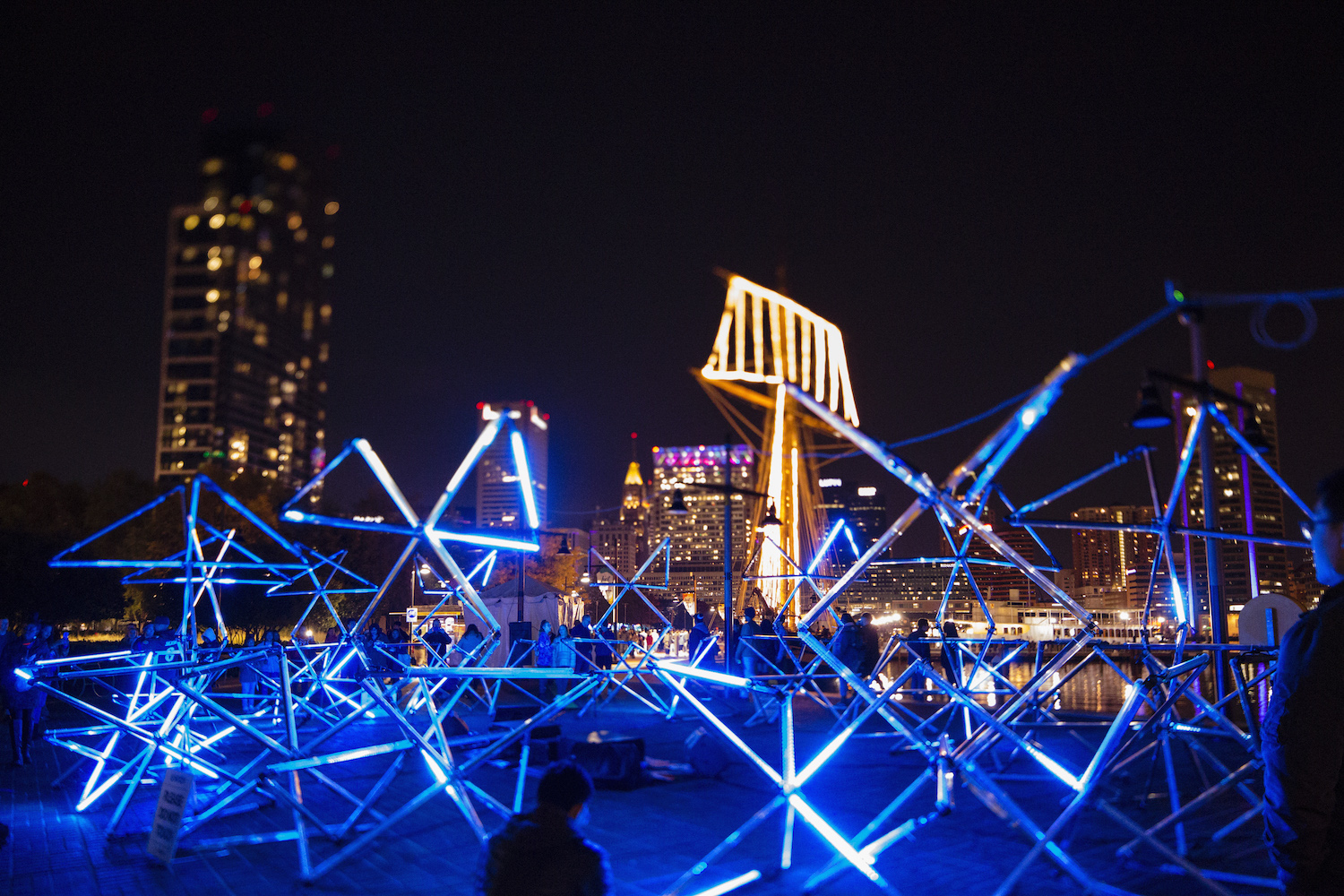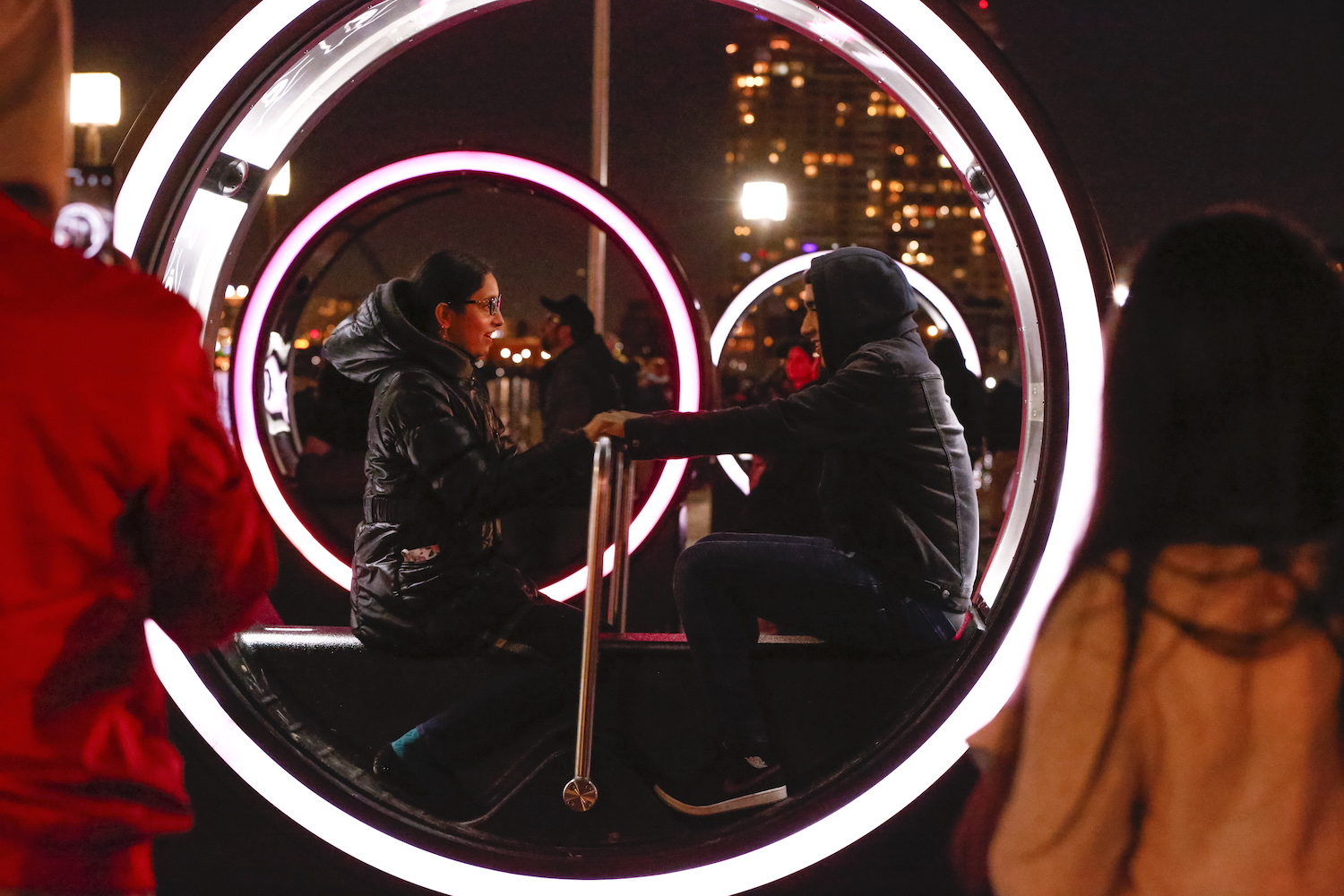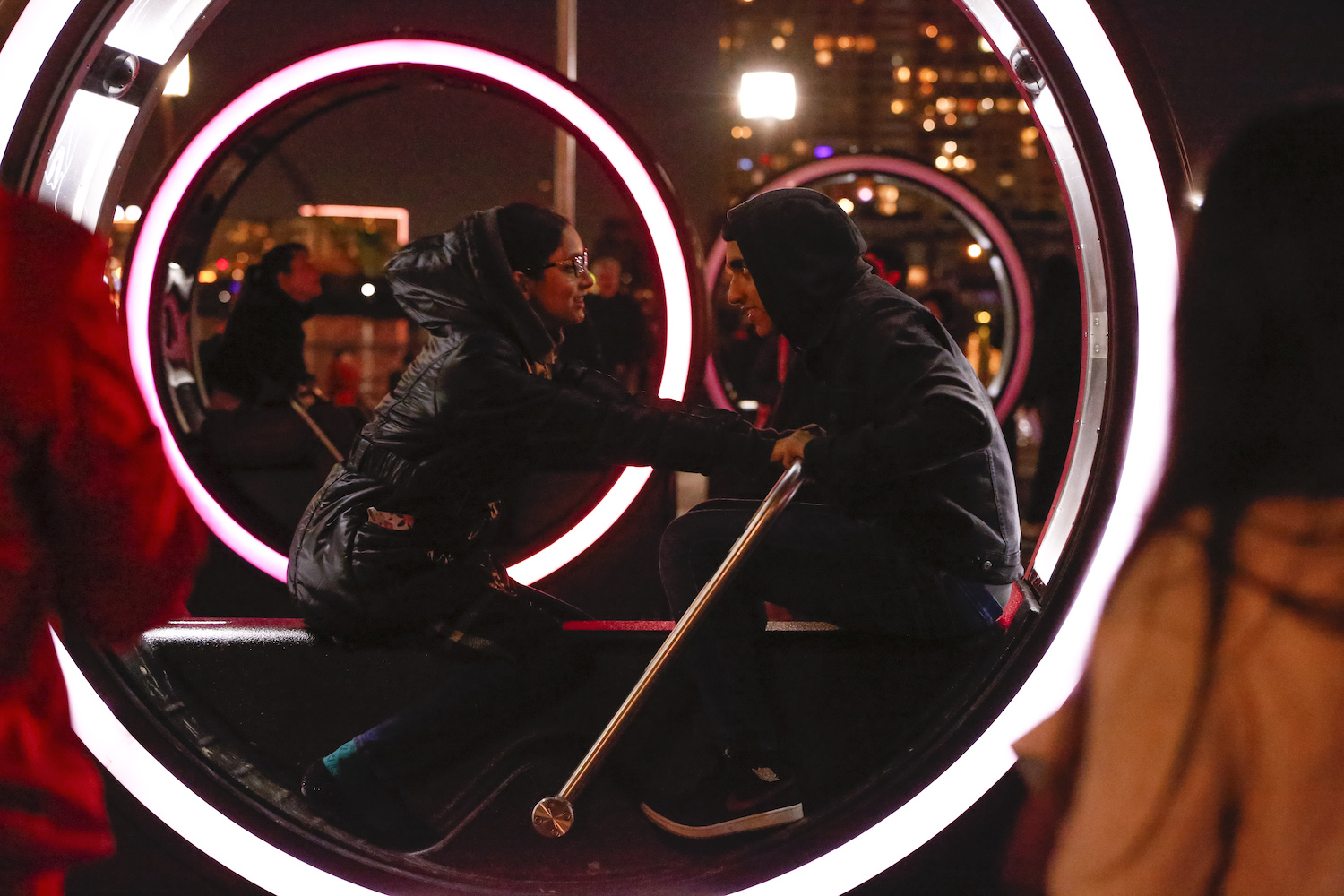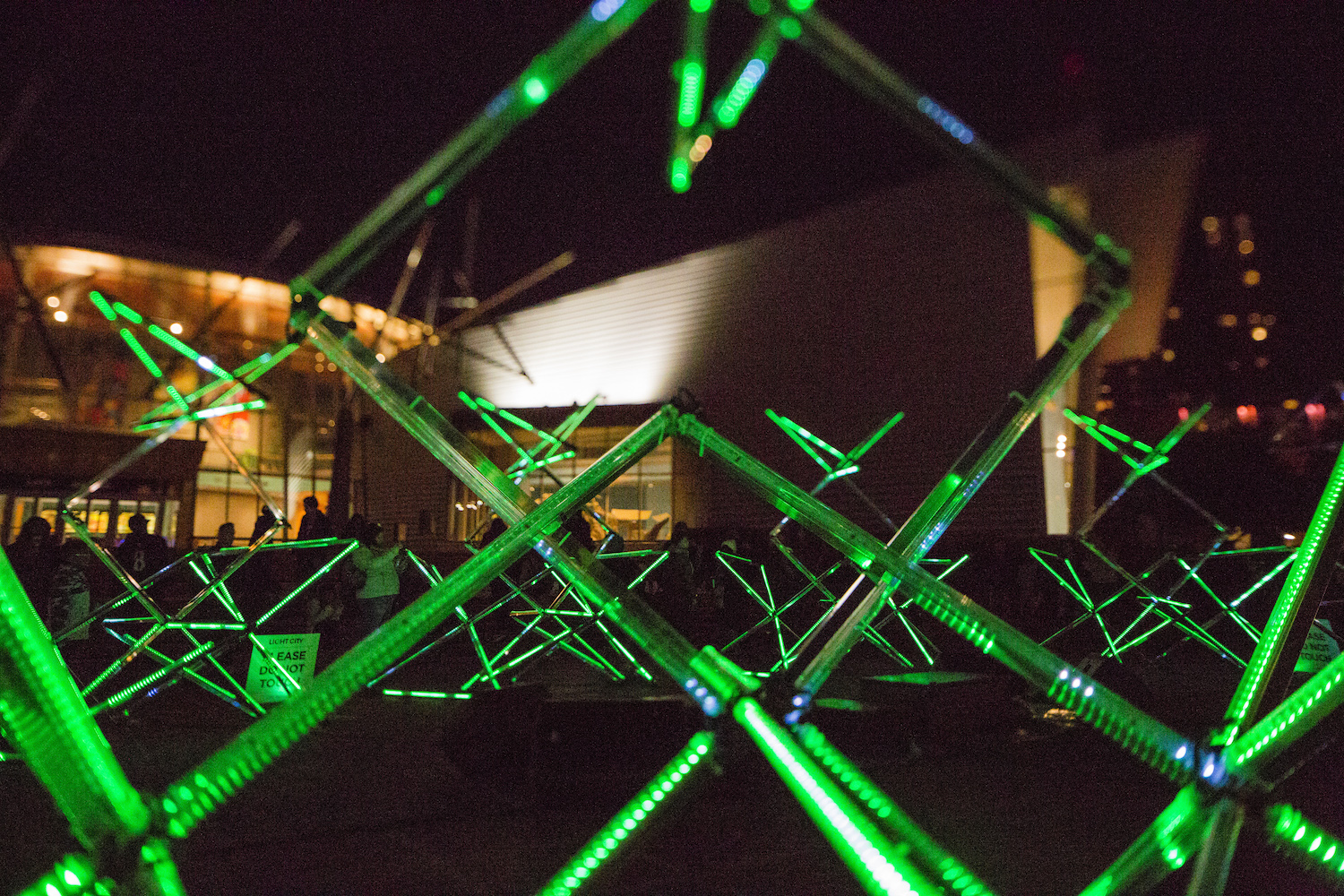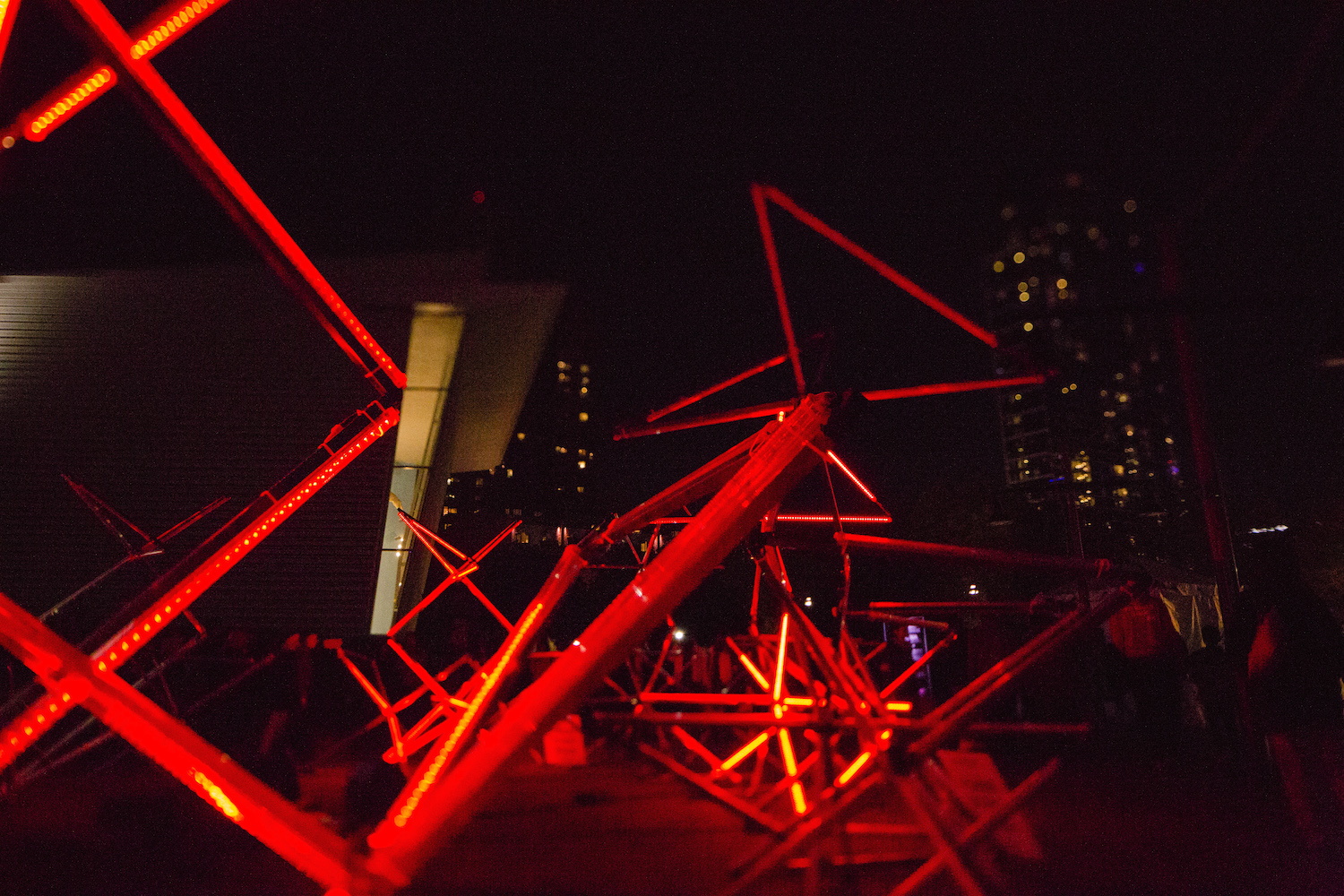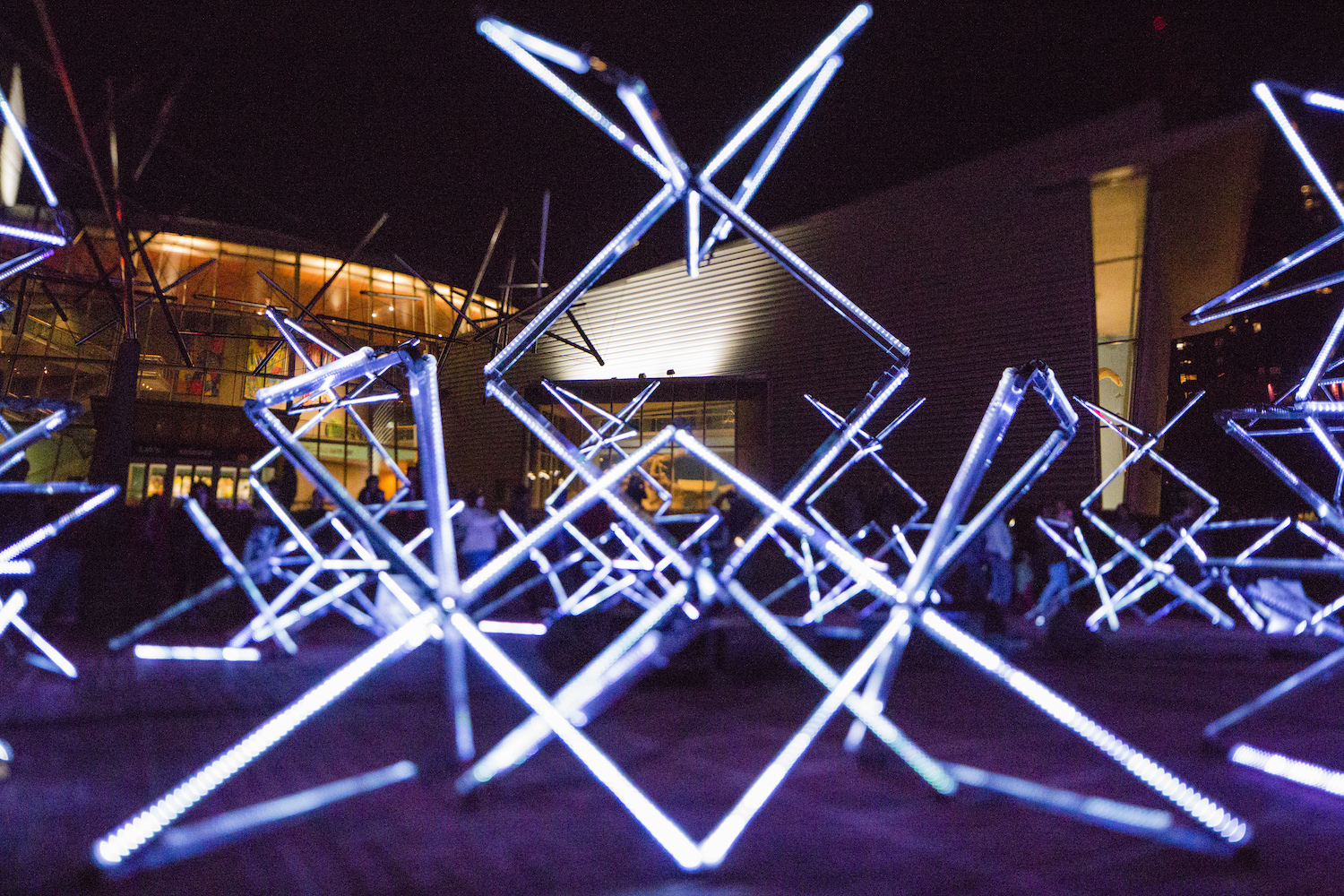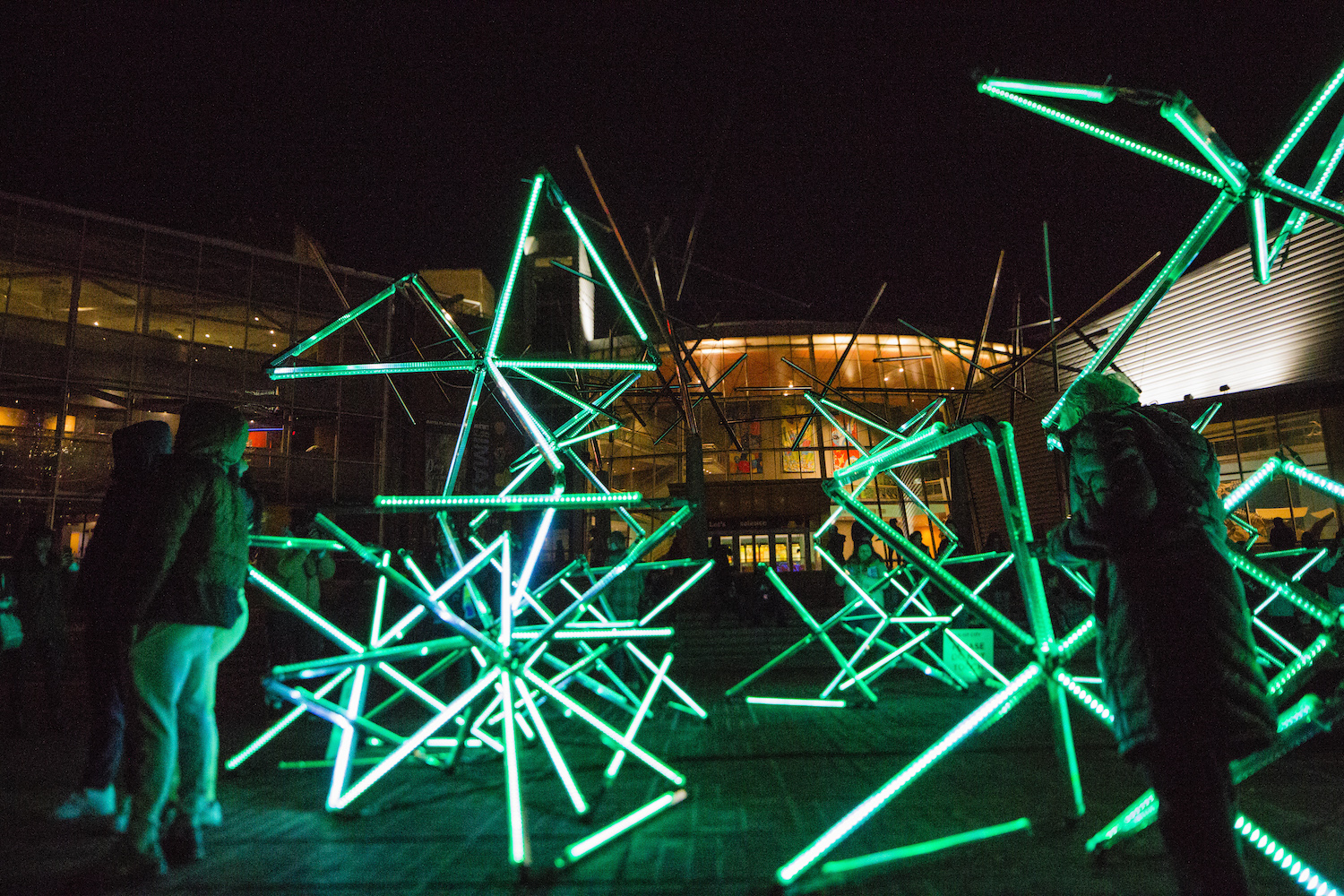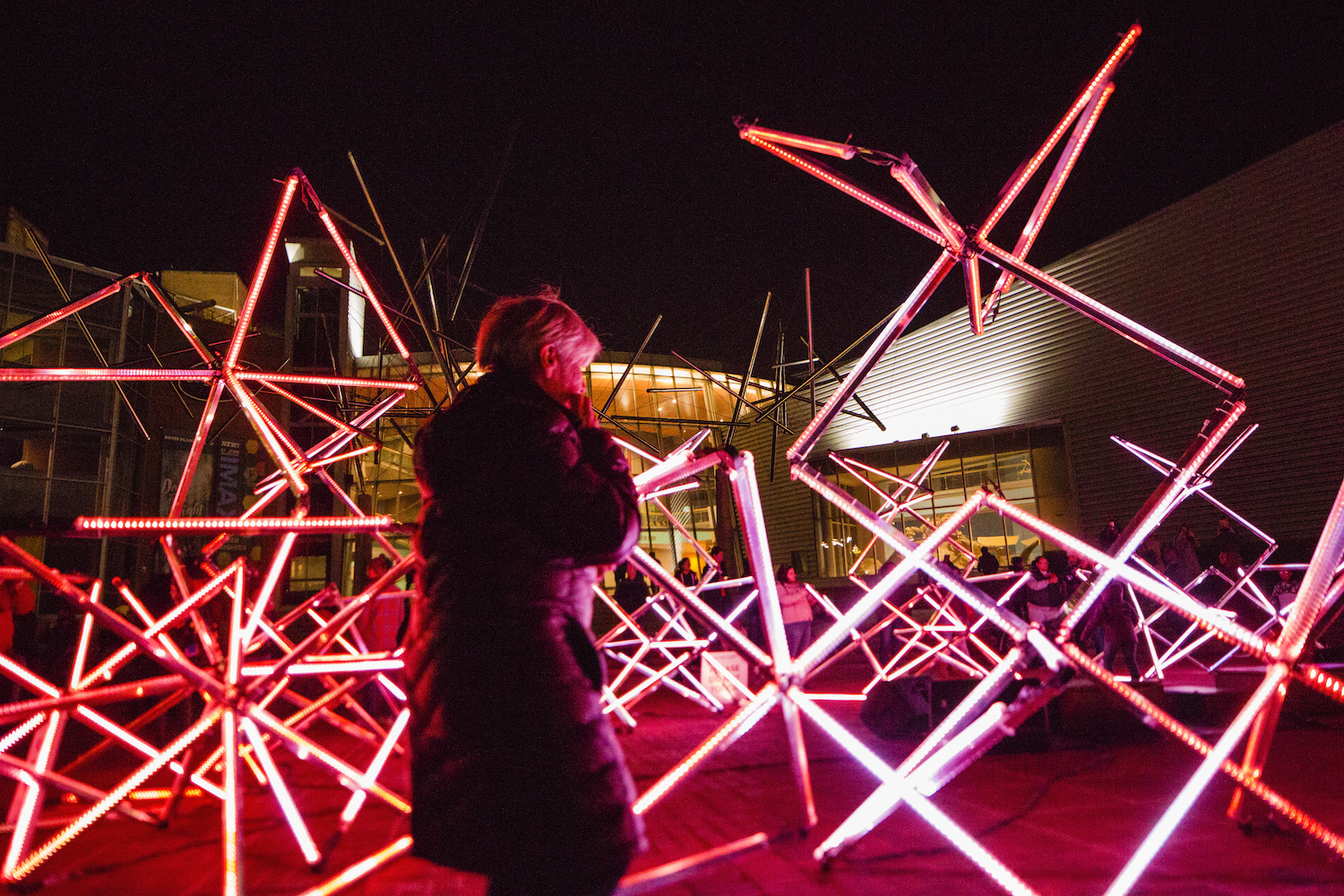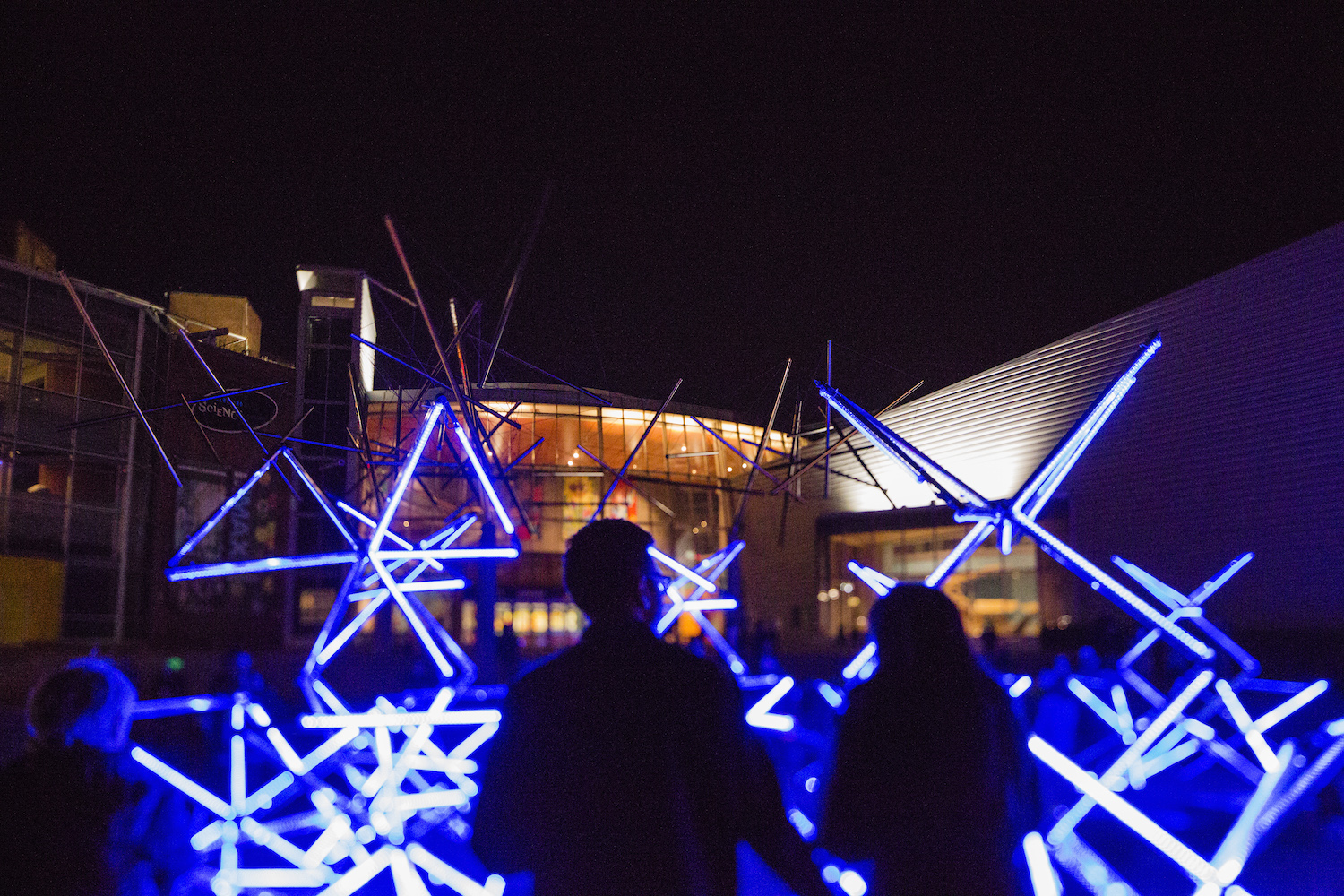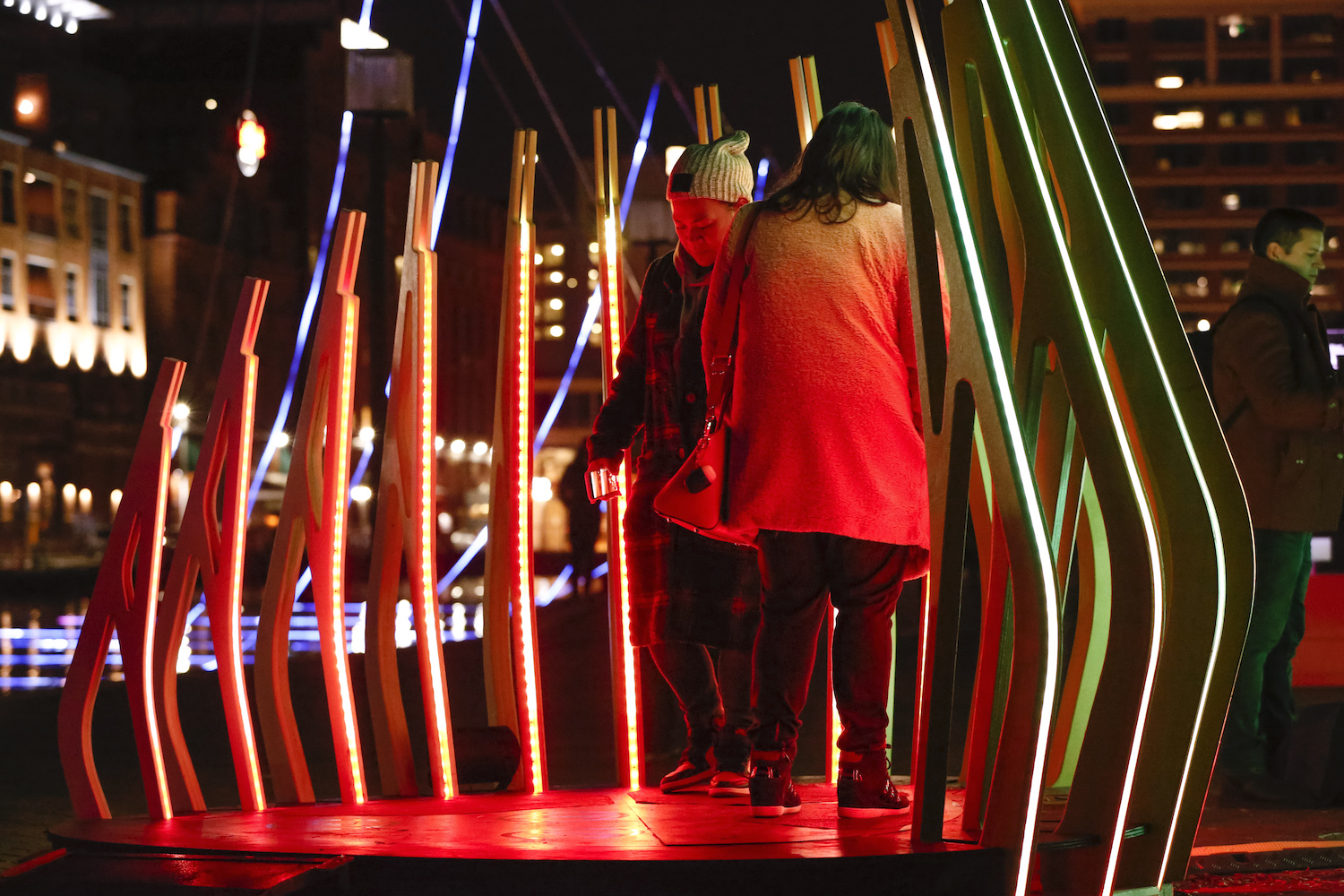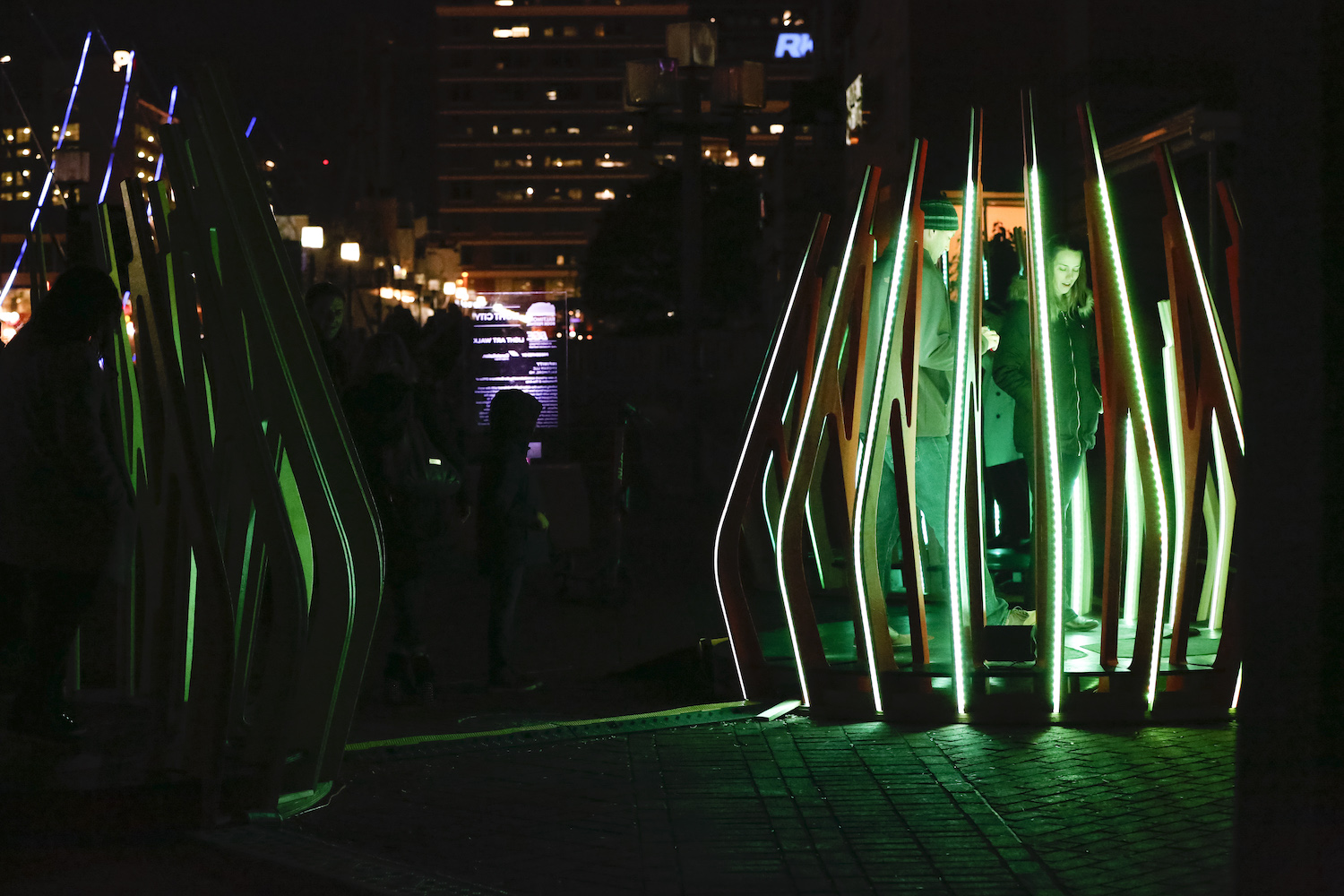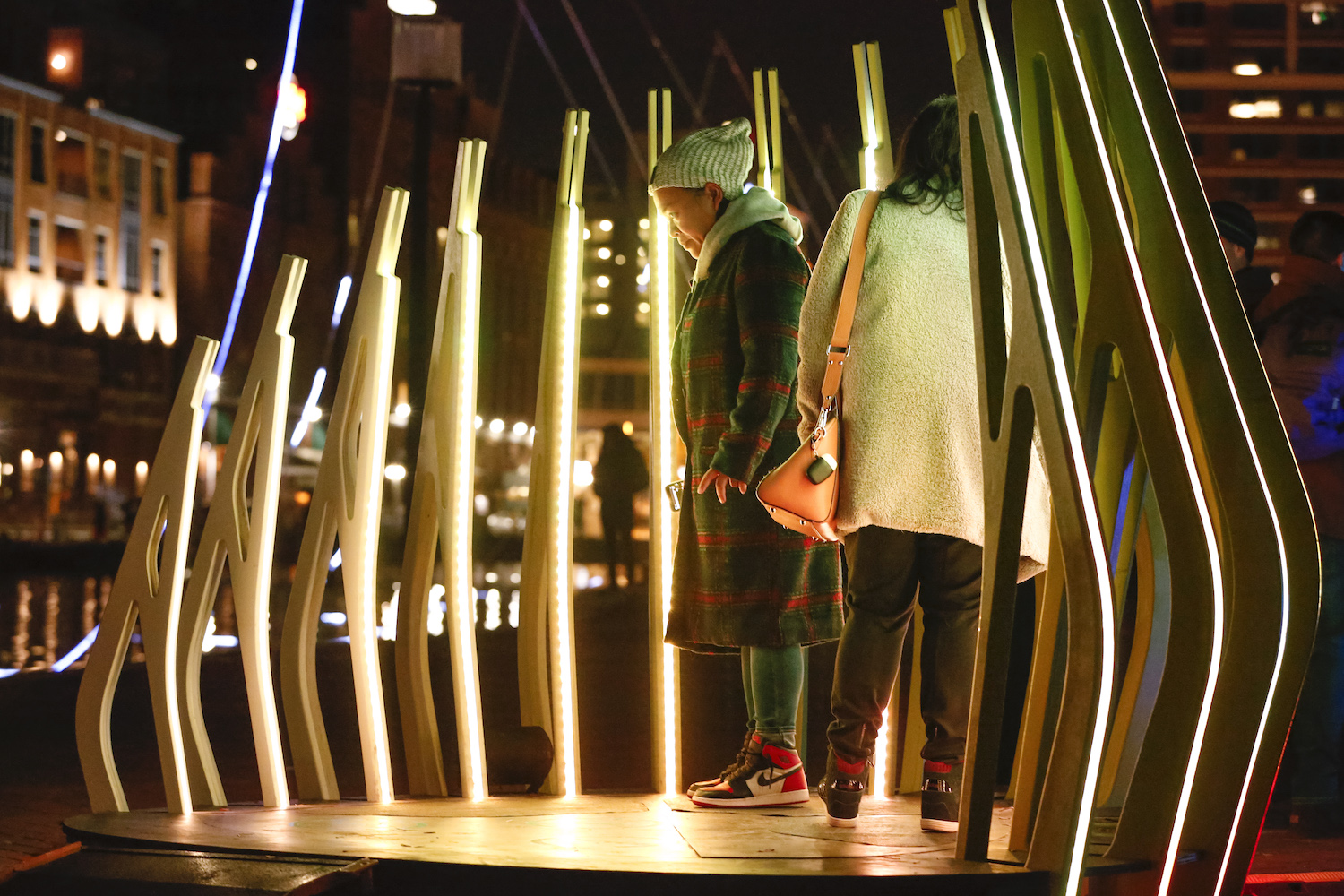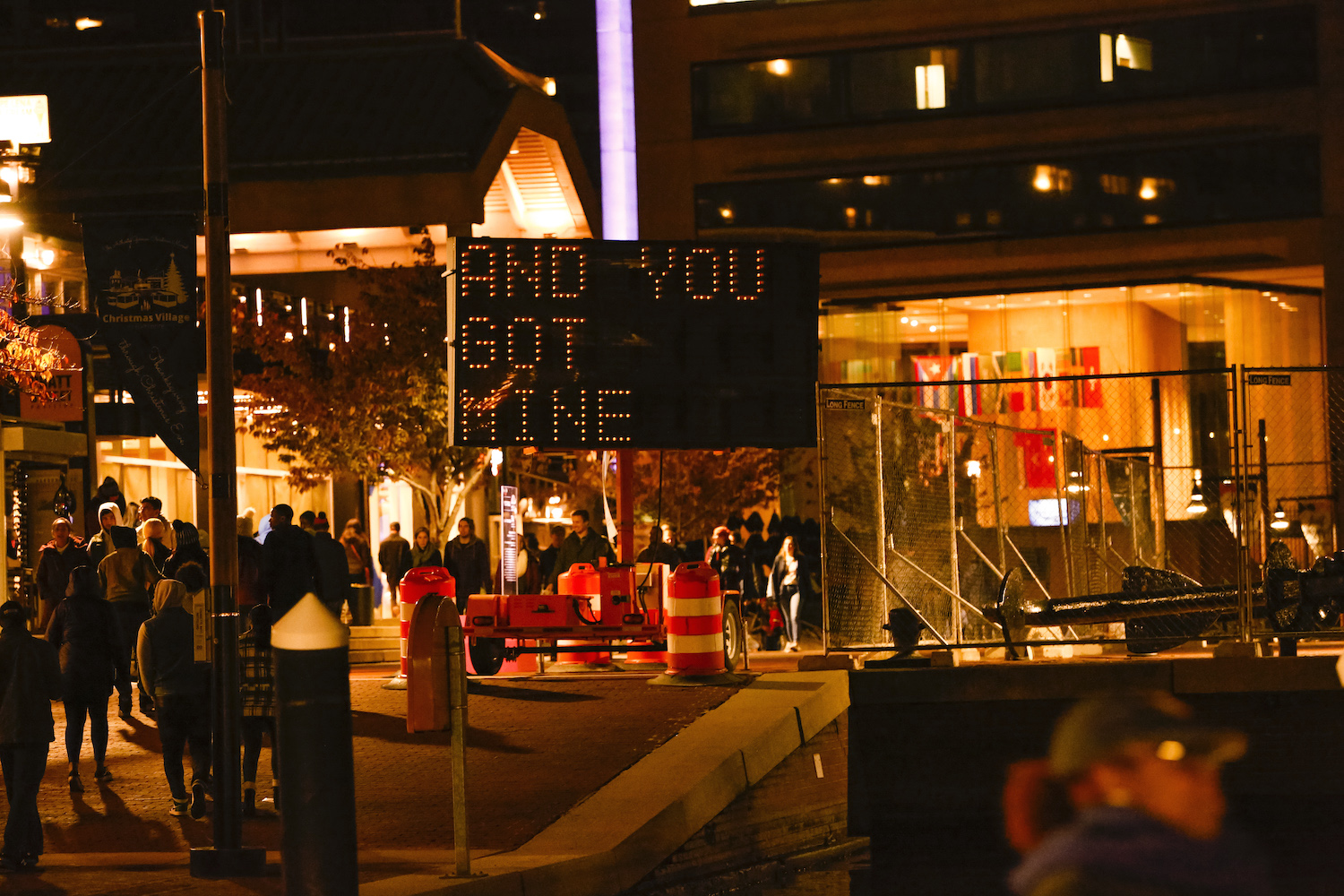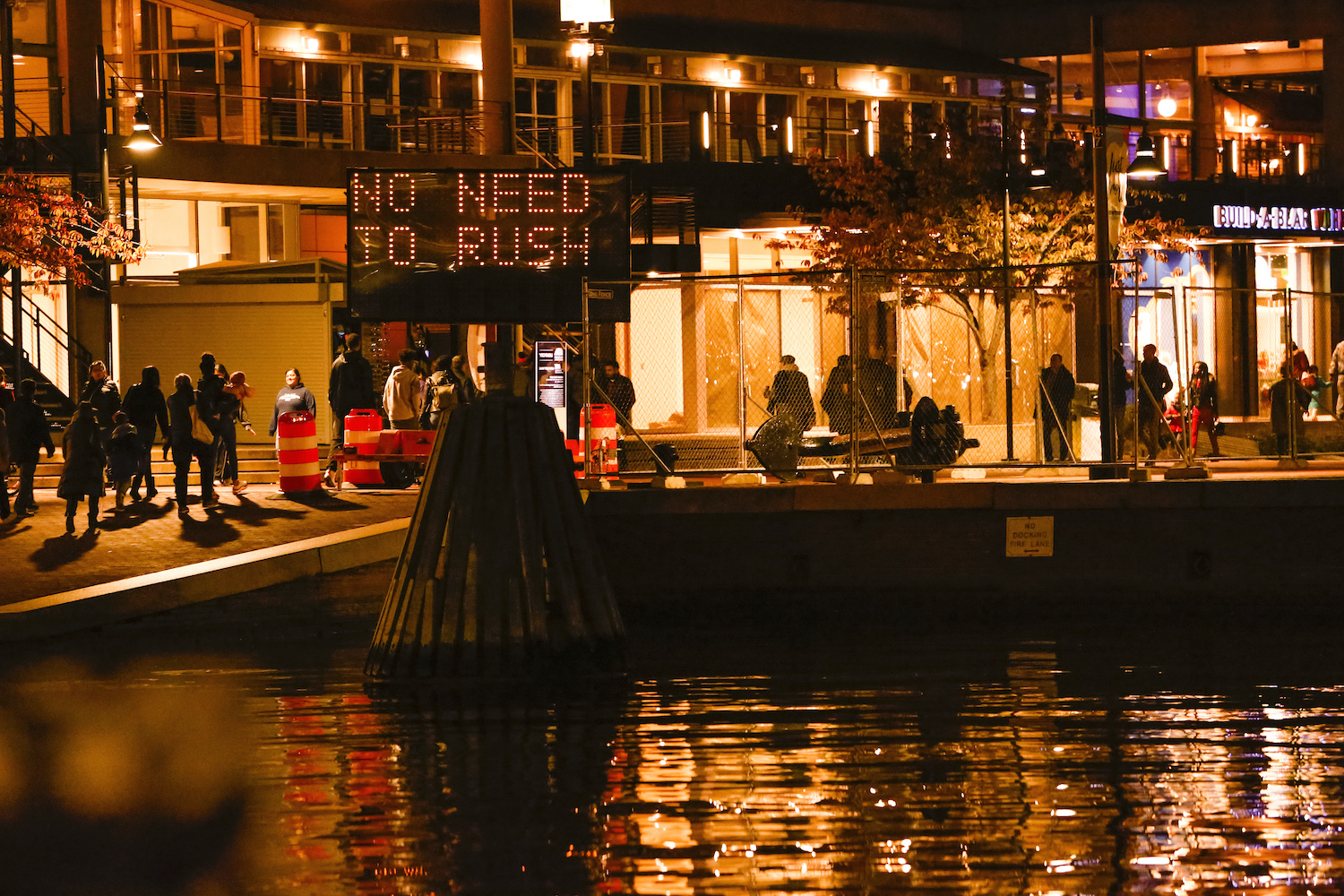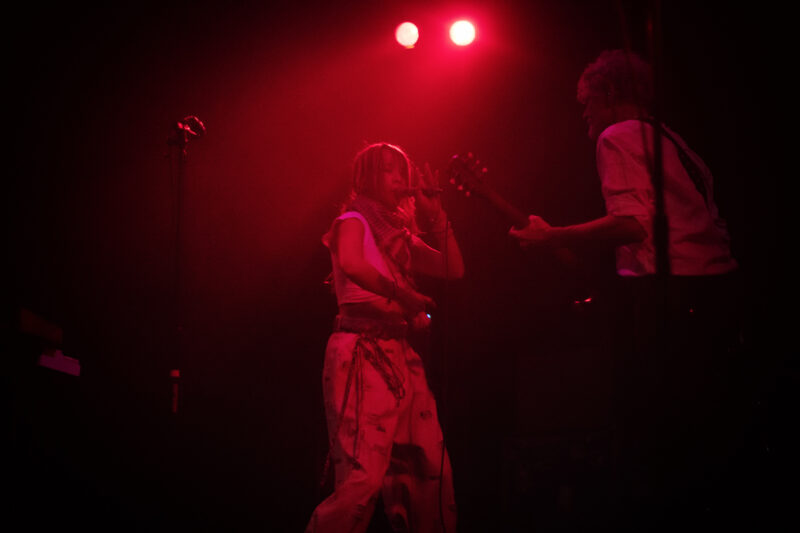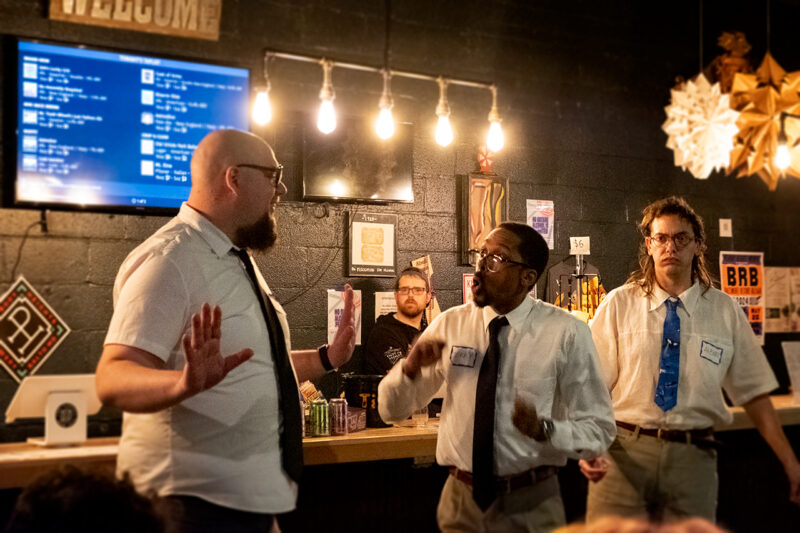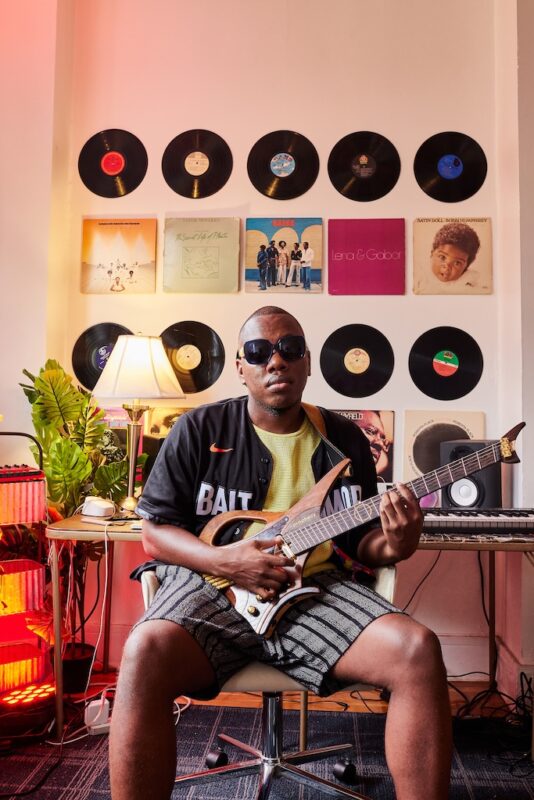This year was the fourth year for Light City, Baltimore’s festival of light, music, discussions, and innovation, organized by the Baltimore Office of Promotions and the Arts. Hosted in Baltimore’s Inner Harbor where the lights twinkle across the water for a maximal effect, this year’s event was moved from March to November and combined with the Baltimore Book Festival under the new name of Brilliant Baltimore.
As in past years, Light City featured a Light Art Walk at the center of its offerings with light installations and sculpture, performances, concerts, a family zone, giant ferris wheel, and the partner program called Neighborhood Lights where artist projects were installed across the city with support from BOPA. The festival’s food and beverage offerings were 100 percent local, reflecting Baltimore’s burgeoning cuisine scene.
Sunday, November 10 was the grand finale of the festival and featured a fireworks performance sending a blaze of color across the Inner Harbor basin. Photographer Jill Fannon was on site to capture the spectacle, the artwork, and the visitors to Light City 2019.

Participating Artists and Projects:
DiscoBug by Tyler Fuqua: DiscoBug takes two iconic symbols from the 60’s & 70’s, the disco ball and the VW Bug, and mashes them into one amazing, interactive art installation. Able to be spun by hand, the Bug is covered on all of its curvy surfaces with thousands of mirror squares. Above the Bug sits a three-legged lighting structure complete with 15 spot lights that are all controlled by a user-friendly control panel. With a bit of teamwork the DiscoBug will create a light show like no other!
Human Tiles by Carole Purnelle with Nuno Maya: Human Tiles is a real-time interactive installation where the public has the key role in forming the graphical patterns that are projected onto a chosen architecture. It is a futuristic interpretation of the heritage, where the city walls become enlivened by people’s interaction on the streets. Using a traditional technique, a video camera captures in real time the movements of visitors as they interact on a white floor. A computer program then transforms their moving image into to a kaleidoscopic projection onto to a nearby building. it is transforming the walls into ever changing ornaments based on the colors and movements of the inhabitants, who are creating their own environment. It is a work that speaks about freedom of movement, diversity of colors and forms, and is bringing people together in a special, unifying way.
Master of the Edifice by Ellis L. Marsalis, III: Masters of the Edifice is a photographic project that displays in light and sound the city of Baltimore thru large photographic reproductions in lightboxes of some of the many painted murals around the City. The photos will recontextualize the murals with their new Inner Harbor surroundings, but remind us of their origins by being framed within black iron piping. There will be two rows of frames approximately 60 to 80 feet long. The visitor will be able to wander down the recreated Baltimore “alley” and view the murals in a context similar to their installation around Baltimore’s neighborhoods. Similarly, speakers will play audio of organic ambient sound recorded throughout the city of Baltimore, conceptually adding further context to the images.
An Abstract Baltimore Story by Jeffrey Kent and Peter Smith: An Abstract Baltimore Story tells the history of Henrietta Lacks, whose immortal cells (HeLa) were harvested and cultured without her knowledge in 1951. Tragically, Ms. Lacks succumbed to cancer that same year at the age of 31, but her HeLa cells became one of the most important tools in medicine, vital for developing the polio vaccine, cloning, gene mapping, in vitro fertilization, the HPV vaccine and more. Jeffrey Kent is an abstract painter who has created works inspired by Ms. Lack’s story. With the technical expertise of Peter Smith, these paintings will be translated into animated abstractions that will be juxtaposed with text that tell the story of Henrietta Lacks and her important HeLa cells and featured on a large outdoor LED screen.
Behind Facades by Stafford-Mcclendon-Srivastava-Dolgin-Harner: Facades juxtaposes the neighborhood Baltimore row home front containing projected interchanging scenes of activity displayed in open windows and doors with the Inner Harbor. Viewers will be invited to step on floor panels which will change sites seen within the window and door frames. In addition, the sound will be triggered that further describes the indoor happenings. The doorsteps will light up when the door scene is activated. When idle, the scenes will show static blinds or a door in the door frame. Conceptually, the artists making up Flux Form wanted to break down barriers that often cause Baltimoreans to feel isolated from one another. They wanted to deliver the opportunity to hear others’ experiences through a familiar medium: the row home – the common thread of many families, generations, and transient residents in a city of stark differences. Their work strives to turn a symbol of compartmentalized intimacy into a powerful storytelling opportunity that is relatable to everyone.
Between the Lines by Pitaya: The Between the Lines installation plays with the scale by showing Huge stylistic fishing rods installed by the water. By night, the rods will nearly disappear in the sky, leaving just long lines of light moving with the wind, hanging softly from mid-air into the sea. Depending on the point of view, the public experience will be totally different: from afar, the lines become an abstraction, a signal.
When the public is close to the rods, the installation becomes an experience depending on the people interaction with the artwork. Beyond the wordplay, the installation invites the visitor to think about how common things could provide different meanings.
Where Pathways Meet by Erick Benitez and Sutton Demlong: Where Pathways Meet is an immersive multimedia installation consisting of light and sound sculptures. The public will be able to navigate through three zones; Mini Garden Maze, Prism House and Rainbow Tunnel in a fluid way, where one zone leads to another. Mini Garden Maze consists of a series of planters housing acrylic plants that are arranged in a circular shape. Prism House is an audio/visual experience that viewers are invited to walk through. Rainbow tunnel is a linear structure that responds to the activity around it. The cumulative experience is a whimsical playground that engages our physicality through sensory input and spatial navigation.
KEYFRAMES by Groupe Laps: The Keyframes installation overtakes the façade of a building in the Inner Harbor where, based on the principles of the 19th century chronophotography and with the help of new technological tools, the building will come alive in what appears to be a dance of moving figures across it. Accompanied by a soundtrack, the lighting program turns more than a hundred stationary figures into an illusion of motion that creates a bridge between sculpture and cinema. During the day, the simple grid framework of the installation will create an intriguing installation surrounding the building’s architecture. Keyframes is sponsored by Baltimore City Department of Public Works – Solid Waste.
Infinity by Epigram LLC: The Infinity Installation of light and sound consists of three cocoon like structures that will invite the user to enter. As the user enters the each one of the three sculptures, the lights will follow them and the sound will change according to their movements. Infinity will encourage the participant to experiment with their movement to understand how they can modify the sound and lights with their varying movements and so that they can experience the virtually unlimited possibilities of the lighting and sound effects. The 3 elements to the sculpture will also provide three differing experiences for the user. And, since the three elements to the sculpture will be installed relatively close to one another, the viewer outside the structures will experience a symphony of light and sound.
Shrooms by Amigo & Amigo: In many cultures mushrooms are considered a symbol of luck, to find a mushroom means that good luck is at hand. Shrooms is an immersive artwork of 13 giant inflatable mushroom shapes that encourages our social nature while contrasting with the grey urban environment. When visitors enter onto the Waterfront Garden on Pier Five they are suddenly in a playful forest filled with joyful signs of good luck. Amigo & Amigo additionally decided to use bold contrasting colored fabrics to create Shrooms so that it not only engaged with visitors and illuminated at night but also is a colorful spectacle that visitors could enjoy during the day. Amigo & Amigo love hijacking public spaces, and embedding them with color, nature, and play.
Loop by Ekumen and Jonathan Villeneuvue: The retro-futuristic machine Loop is a cross between a music box, a zoetrope and a railway handcar, that creates animated fairy-tales. Through the combined efforts of members of the public working the hand lever, the image cylinder lights up and creates the illusion of motion in the drawings. The black and white images, tinted through a strobe effect, recall the earliest movies. The speed at which the images fly by, the frequency at which the light flickers and the rhythm of the audio composition are directly related to the pace set by the participants, who can be of any age.
The Canopy by Can-Duit and Peuhaus: The Canopy is an interactive and kinetic experience. 12 bikes activate 12 sculptural forms, which rise into place as visitors pedal. With each module inflating and deflating, an emergent space will form of a canopy appearing, morphing and disappearing, colored lights shining within. The tips of each shape point directly at the tips of its neighbors suggesting a continuous surface. This aspect was inspired by the phenomenon in tree canopies called Crown Shyness where trees will maintain a slight gap between each others’ branches.
(off)Lines by Pierre Ranzini: The (off)Lines installation is an architectural modular construction. It consists of 320 linear meters of square bars, each equipped with a 1 meter long LED light tube. The total structure is a series of geometric entanglements of several colors randomly forming a sequence of shapes that form and then disintegrate into space. In total, it is more than 7,000 LEDs that are controlled within the space of this geometric structure, but change, creating a versatile sculpture whose light movement enliven the space around it and encourage the viewer to linger to experience the numerous shapes created by the alternatingly illuminated LED tubes.
MAPP by AlexP: MAPP is an abbreviation of Mapping At Private Properties. It is a mobile point-and-shoot video projection mapping system. The installation consists of a video projector, a camera and a laptop running custom software developed by AlexP. Everything is mounted together on a pram. MAPP makes a scan of its surroundings using the camera and subsequently shows an abstract and moving video mapping. Visitors of Light City can “step into the light” and become part of the artwork. Once the scan of the visitors has been made, they walk out of the light and see themselves in the colorful projection. Don’t forget to bring your camera for your light-art-selfies!
Waterlight Graffiti by Antonin Forneau: Waterlight Graffitiis an interactive artwork in the form of a wall of thousands of LEDs that are illuminated when they come in contact with water. The public is invited to express itself on this luminous surface by drawing or writing with a brush or a spray – similar to shooting stars, messages and drawings will emerge from the darkness and fade away. This patented technology is based on a simple physical principle of using water as an electricity conductor. Comparable to a switch, the LEDs light up at the slightest touch with the water and go out as the water evaporates or is wiped away.
Radiant Flux by Kevin Blackistone: Radiant Flux is an interactive sculpture consisting of over 100 independently moving triangular mirrors exploring the many facets of light through solar reflectance by day and moonbeams at night. By day, participants will have glints of sunlight cast upon them while having their mirrored image form and deconstruct itself in oscillating patterns. At night, the reflections will continue but will create a light display of colored shards moving with the participants and colored by the pulses of music
Baltimore Fancy by Michael Bowman and Formstone Castle Collective: Baltimore Fancy tells the story of the Arabbers, Baltimore’s traditional street vendors. It consists of two elements—a lit and decorated Arabber horse and cart, and a stable, where a magical canopy will provide a sense of place and history. Each night, the stable and cart first present an ethereal light show. Like a vacant store-front or an empty neighborhood, they are mere ghosts. Then, as Arabber and horse arrive and harness up to the cart, the light show comes colorfully alive, reminding us that it is only through use and human interaction that traditions are sustainable and our neighborhoods remain alive.
Words That Light (multiple locations) by Peter Quinn and Todd Evans: Words That Light is a project that will transform the classic solar powered road work message boards into short-burst poems that will surprise, delight, and inspire people as they go on their way during the week of Light City. These lightboards will be located in heavily trafficked areas entering and exiting downtown and along the Light City footprint. Using these message boards will flip these signs that we identify as headaches or warnings into reflective poetic messages that help us imagine our human potential. Light is a symbol of life, inspiration, and transformation – especially where it’s least expected.
Spark Gallery, a project co-produced by UMBC and Towson University and curated by Catherine Borg.














































